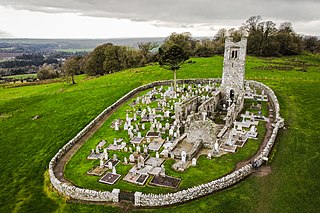
Slane is a village in County Meath, in Ireland. The village stands on a steep hillside on the left bank of the River Boyne at the intersection of the N2 and the N51. As of the 2022 census, Slane's population was 1,445. The village and surrounding area contains many historic sites dating back over 5,000 years. The village centre, as it is laid-out today, dates mainly from the 18th century. The village is in a townland and civil parish of the same name.

Irish whiskey is whiskey made on the island of Ireland. The word 'whiskey' comes from the Irish uisce beatha, meaning water of life. Irish whiskey was once the most popular spirit in the world, though a long period of decline from the late 19th century onwards greatly damaged the industry, so much so that although Ireland boasted at least 28 distilleries in the 1890s, by 1966 this number had fallen to just two, and by 1972 the remaining distilleries, Bushmills Distillery and Old Midleton Distillery, were owned by just one company, Irish Distillers.
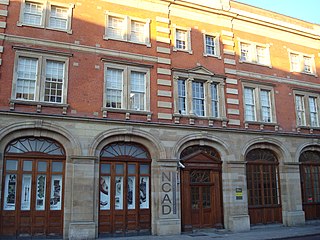
The National College of Art and Design (NCAD) is Ireland's oldest art institution, offering the largest range of art and design degrees at undergraduate and postgraduate level in the country. Originating as a drawing school in 1746, many of the most important Irish artists, designers and art educators have studied or taught in the college. NCAD has always been located in central Dublin, and in 1980 it relocated to the historic Liberties area. The College has around 950 full-time students and a further 600 pursuing part-time courses, and NCAD's students come from more than forty countries. NCAD is a Recognised College of University College Dublin. It is also a member of the European League of Institutes of the Arts.

The River Poddle is a river in Dublin, Ireland, a pool of which gave the city its English language name. Boosted by a channel made by the Abbey of St. Thomas à Becket, taking water from the far larger River Dodder, the Poddle was the main source of drinking water for the city for more than 500 years, from the 1240s. The Poddle, which flows wholly within the traditional County Dublin, is one of around a hundred members of the River Liffey system, and one of over 135 watercourses in the county; it has just one significant natural tributary, the Commons Water from Crumlin.

Thomas Street is a street in The Liberties in central Dublin, Ireland.
Pimlico is an inner city area of Dublin, Ireland on the southside in Dublin 8. It lies between Thomas Court and Ardee Street. At the Thomas Court end of Pimlico is Pimlico Cottages. It is close to the St. James's Gate Guinness Brewery. Similar to other areas of Dublin's Liberties, such as The Coombe, Pimlico was historically home to families of weavers many of whom had emigrated from France via London.
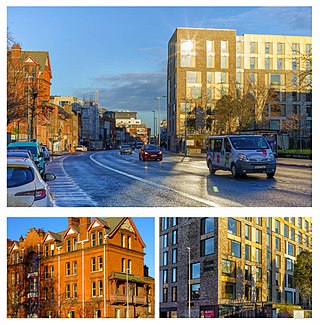
Cork Street runs from the junction of The Coombe to Donore Avenue.

St. James' Church is a former Church of Ireland church in James's Street, Dublin, Ireland. Established in 1707, the corresponding parish, which was separated from that of nearby St. Catherine's, was established in 1710. There had been a shrine dedicated to St. James at nearby St. James's Gate, a stopping-off point for pilgrims, since medieval times. It has been proposed that the current church is near to the site of a church to St. James of Compostella which is first referred to in the mid-13th century.
The Manor of St. Sepulchre was one of several manors, or liberties, that existed in Dublin, Ireland since the arrival of the Anglo-Normans in the 12th century. They were townlands united to the city, but still preserving their own jurisdiction. St. Sepulchre's was under the jurisdiction of the Archbishop of Dublin, although from time to time the Dublin city government claimed ownership of it.

The Liberty of Thomas Court and Donore was one of several manors, or liberties, that existed in County Dublin, Ireland since the arrival of the Anglo-Normans in the 12th century. They were adjacent to Dublin city, and later entirely surrounded by it, but still preserving their own separate jurisdiction.

The Deanery of St Patrick was one of several manors, or liberties, that existed in Dublin, Ireland since the arrival of the Anglo-Normans in the 12th century. They were town lands united to the city, but still preserving their own jurisdiction. The Lord of the Manor was the Dean of St Patrick's Cathedral, Dublin. In the 19th century it was the smallest of the liberties of Dublin.

St. Luke's Church is a former Church of Ireland parish church in Dublin, Ireland. It is located on The Coombe, not far from St. Patrick's Cathedral.

The Coombe is a historic street in the south inner city of Dublin, Ireland. It was originally a hollow or valley where a tributary of the River Poddle, the Coombe Stream or Commons Water, ran. The name is sometimes used for the broader area around, in which the Poddle and its related watercourses featured strongly.
Hugh Inge or Ynge(c. 1460 – 3 August 1528) was an English-born judge and prelate in sixteenth century Ireland who held the offices of Bishop of Meath, Archbishop of Dublin and Lord Chancellor of Ireland.
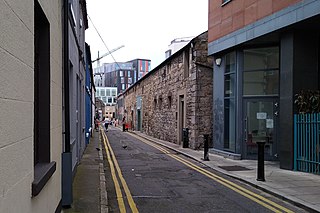
Fumbally Lane is a narrow and historic street in Dublin, Ireland, south of the city centre in The Liberties, 'In name and character perhaps the most evocative of all the Liberties' streets.' It connects Blackpitts to New Street and is close to St Patrick's Cathedral.
The Thomas Street Distillery was an Irish whiskey distillery located in Dublin, Ireland. At its peak, it was Dublin's largest and most productive distillery and with an output of over 2 million gallons per annum, twice that of John Jameson's acclaimed nearby Bow Street distillery. Alfred Barnard, a British author who visited most of the distilleries in the then United Kingdom of Great Britain and Ireland in the late 1880s, wrote that, at the time of his visit, the Thomas Street Distillery may have been the largest whiskey distillery in the world and probably had the highest output of any whiskey distillery in the British Isles. However, the distillery later entered into financial difficulties, and closed in 1926. Although most of the distillery buildings were demolished following its closure, a few were incorporated into the Guinness St. James's Gate Brewery and are still extant.

Teeling Distillery is an Irish whiskey distillery established in Dublin in 2015 by the Teeling Whiskey Company and owned by Bacardi Limited.
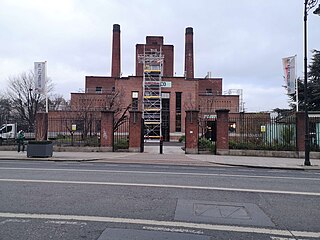
Roe & Co Distillery is an Irish whiskey distillery established in 2019, owned by Diageo. It is located on Thomas Street, Dublin, Ireland, near the Guinness' St. James' Gate brewery.

The Dublin whiskey fire took place on 18 June 1875 in the Liberties area of Dublin. It lasted a single night but killed 13 people, and resulted in €6 million worth of damage in whiskey alone. People drank from the 6 inches (15 cm) deep river of whiskey that is said to have flowed as far as the Coombe. None of the fatalities suffered during the fire were due to smoke inhalation, burns, or any other form of direct contact with the fire itself; all of them were attributed to alcohol poisoning from drinking the undiluted whiskey running through the streets that had been stored in casks that exploded; this alcohol was much more potent than whiskey offered at retail in bottles.



















